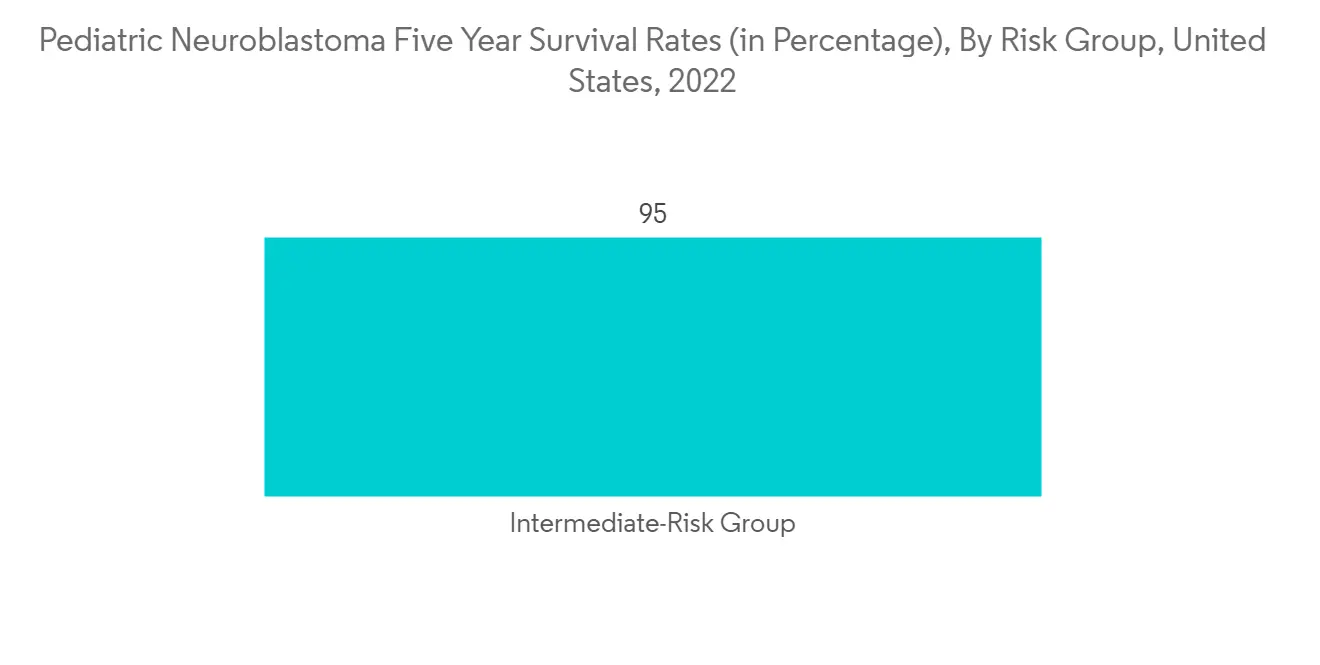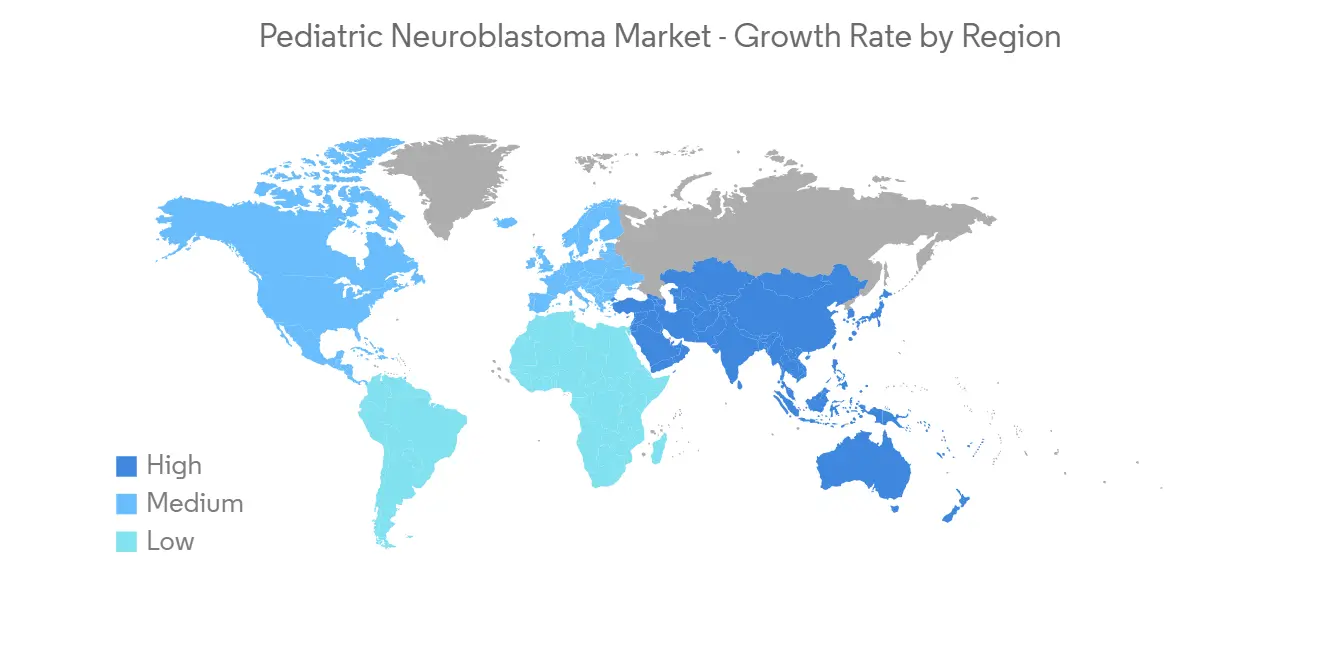 |
市場調査レポート
商品コード
1273427
小児神経芽腫治療市場- 成長、動向、予測(2023年~2028年)Pediatric Neuroblastoma Treatment Market - Growth, Trends, and Forecasts (2023 - 2028) |
||||||
● お客様のご希望に応じて、既存データの加工や未掲載情報(例:国別セグメント)の追加などの対応が可能です。 詳細はお問い合わせください。
| 小児神経芽腫治療市場- 成長、動向、予測(2023年~2028年) |
|
出版日: 2023年04月14日
発行: Mordor Intelligence
ページ情報: 英文 120 Pages
納期: 2~3営業日
|
- 全表示
- 概要
- 目次
小児神経芽腫治療市場は、予測期間中に約6.3%のCAGRで推移すると予測されています。
COVID-19のパンデミックは、世界経済とヘルスケアインフラの両方に大きな影響を及ぼしました。小児神経芽腫治療市場は、医療供給が途絶え、神経芽腫治療薬や治療法の履行が遅れたため、深刻な影響を受けました。例えば、2021年1月にPubMedに掲載された論文では、COVID-19期間中に化学療法、放射線療法、手術、画像検査を受けた小児患者の日平均人数が大幅に減少したと述べられています。しかし、小児神経芽腫の負担の増加や小児神経芽腫の治療法の研究開発の増加により、今後数年間は市場の成長が見込まれます。
米国国立がん研究所(NCI)の2021年11月の更新情報によると、小児(0~14歳)の場合、最も多いがんの種類は白血病で、脳やその他のCNS腫瘍、リンパ腫、神経芽腫、腎臓腫瘍、悪性骨腫瘍と続く。同じソースによると、2021年には、0歳から19歳までの子供と青少年が15,590人、がんと診断される可能性があると推定されています。
さらに、小児医療インフラを構築するための研究開発イニシアチブへの政府の投資増加や、小児神経芽腫治療に対する国民の知識の高まりが、市場の拡大を促進しています。例えば、小児がん研究のためのラリー財団は、2022年3月、神経芽腫における染色体17qゲインの役割を研究するMiller Huang博士とSatyaki Sengupta博士、小児神経芽腫の治療の新規MYCN阻害剤を見つけるMuxiang Zhou博士などの研究者に340万米ドルを助成金として付与しました。
一方、がん治療に伴う高コストや副作用が、予測期間中の市場成長を抑制する可能性があります。
小児神経芽腫治療市場の動向
予測期間中、小児神経芽腫治療市場は化学療法分野が成長を遂げると予測される
化学療法では抗がん剤が使用され、静脈に注射されることが多いです。抗がん剤は、がん細胞を見つけて死滅させるために、血流にのって全身に行き渡ります。そのため、化学療法は、肝臓、肺、リンパ節、骨髄、肝臓、またはその他の臓器に転移した神経芽腫の治療に使用することができます。神経芽腫の治療における化学療法薬の有効性と、小児人口におけるこの疾患の発生率の上昇が、このセグメントの成長率上昇の主な原因となっています。
また、化学療法は、症状を軽減し、病気の広がりを抑えるための治療方法として好まれています。より良い結果を得るために、放射線療法や手術のような他の治療法と組み合わせて使用されることもあります。例えば、2021年6月、メモリアル・スローン・ケタリングがんセンターは、N9が神経芽腫の子どもたちにとって安全で効率的な治療法であるかどうかを判断することに焦点を当てた臨床研究を後援しました。シクロホスファミド、トポテカン、ビンクリスチン(CTV)、イホスファミド、カルボプラチン、エトポシド(ICE)、シクロホスファミド、ドキソルビシン、ビンクリスチンという3つの化学療法薬の組み合わせがN9レジメン(CDV)を構成しています。さらに、2022年6月にASCO誌に掲載された論文によると、新たに高リスク神経芽腫と診断された患者さんに対するChildren's Oncology Group(COG)の化学療法サイクル3-5にジヌツキシマブ(DIN)とサルグラモスチム(GM-CSF)を投与すると忍容性と実行可能性があるとされています。
化学療法は、小児の特定の神経芽細胞腫患者の治療に、手術の前または後に使用されます。特に、がんが進行しすぎて手術では完全に根絶できない場合などには、化学療法が主な治療となることが少なくありません。また、小児神経芽腫の治療における化学療法の有効性を研究するための投資が増加することで、調査中の市場は発展すると考えられます。例えば、Jason Shohet, MD, Ph.D.は、神経芽腫の化学療法治療における薬剤耐性の克服を研究するために、2022年1月に新たに2年間で30万米ドルのScholar Hope Grantを授与されました。この新しい助成金では、酵素PRMT5ターゲティングと既存の治療法を組み合わせる最適な方法を理解することに焦点を当てると予想されます。さらに、米国がん協会の2022年最新情報によると、15歳未満の小児における神経芽腫の5年生存率は82%です。低リスクの神経芽腫の子どもでは、5年生存率は95%以上と高いです。中リスクの神経芽腫の子どもでは、5年生存率は90%から95%です。高リスクの神経芽腫では、5年生存率は50%程度です。低リスクと中リスクの場合、適切な化学療法やその他の補助療法によって、生存率のほとんどが改善されます。このため、化学療法の採用は増加し、市場の成長を後押しするものと思われます。

北米が小児神経芽腫治療市場の成長を牽引し、予測期間中も成長が期待される
北米は、小児神経芽腫の発生頻度が高いこと、ヘルスケアインフラが整備されていることなどの要因から、市場の成長が期待されます。また、政府の奨励策や研究協力の増加も、市場拡大を後押しすると予想される要因の一つです。医療法制の整備、患者数の多さ、新興国市場の開拓により、米国はこの地域で最大のシェアを占めると予想されています。
米国臨床腫瘍学会(ASCO)の2022年2月の更新によると、北米では、神経芽腫が0歳から14歳の間に毎年700から800人の子供に影響を与えました。6%.同じソースによると、5歳未満の子どもが神経芽腫の症例のおよそ90%を占めるとされています。診断の典型的な年齢は1~2歳です。
さらに、同市場における製品承認は、競合他社の製品ポートフォリオを広げ、効果的な治療を増やすと予想され、市場拡大の原動力となりそうです。例えば、2022年6月、FDAは、神経芽腫からの中枢神経系またはレプト髄膜転移(脳と脊髄を包む脳脊髄液に転移する疾患)を有する小児の治療に対する生物製剤承認申請の優先審査をOmblastys(omburtamab)に付与しました。
さらに、共同研究、合併、買収など、重要な市場参入企業によるイニシアティブの拡大も、市場の拡大に大きく貢献するでしょう。例えば、2021年8月、United Therapeutics Corporationは、元NFL選手のDevon Stillとその娘で高リスク神経芽腫の生存者であるLeahとパートナーシップを結び、教育プログラム「Braving NeuroBLASToma」を導入し、未熟な神経細胞である神経芽細胞を冒す珍しいがんに対する認知度を高めました。

小児神経芽腫治療産業の概要
小児神経芽腫治療市場は適度な競争があり、複数の大手企業で構成されています。現在、市場を独占している企業には、United Therapeutics Corporation、APEIRON Biologics AG、Baxter、CELLECTAR BIOSCIENCES, INC、Pfizer, Inc、Bayer AG、MacroGenics, Inc、およびSartorius AGがあります。製品の発売、パートナーシップやコラボレーション、研究開発への継続的な投資などは、企業が市場シェアを拡大するために採用している戦略の一部です。
その他の特典:
- エクセル形式の市場予測(ME)シート
- 3ヶ月間のアナリストサポート
目次
第1章 イントロダクション
- 調査の前提条件と市場定義
- 本調査の対象範囲
第2章 調査手法
第3章 エグゼクティブサマリー
第4章 市場力学
- 市場概要
- 市場促進要因
- 小児神経芽腫の負担増と研究開発の増加
- がんの治療法に対する認識の高まり
- 市場抑制要因
- がん治療に伴う高コストと副作用
- ポーターのファイブフォース分析
- 新規参入業者の脅威
- 買い手/消費者の交渉力
- 供給企業の交渉力
- 代替品の脅威
- 競争企業間の敵対関係
第5章 市場セグメンテーション(金額ベース市場規模:USD Million)
- 治療タイプ別
- 化学療法
- 免疫療法
- その他の治療タイプ
- 販売チャネル別
- 病院薬局
- 小売薬局
- 地域別
- 北米
- 米国
- カナダ
- メキシコ
- 欧州
- ドイツ
- 英国
- フランス
- イタリア
- スペイン
- その他欧州
- アジア太平洋地域
- 中国
- 日本
- インド
- オーストラリア
- 韓国
- その他アジア太平洋地域
- 中東・アフリカ地域
- GCC
- 南アフリカ
- その他中東とアフリカ
- 南米
- ブラジル
- アルゼンチン
- その他南米地域
- 北米
第6章 競合情勢
- 企業プロファイル
- United Therapeutics Corporation
- APEIRON Biologics AG
- Baxter International
- Pfizer, Inc.
- Bayer AG
- MacroGenics, Inc.
- Sartorius AG
- CELLECTAR BIOSCIENCES, INC.
- PROVECTUS BIOPHARMACEUTICALS, INC.
- Y-mAbs Therapeutics, Inc.
- Amgen
- Eli Lilly and Company
- F. Hoffmann-La Roche Ltd
第7章 市場機会および将来動向
The pediatric neuroblastoma treatment market is projected to register a CAGR of nearly 6.3% over the forecast period.
The COVID-19 pandemic had a significant impact on both the global economy and healthcare infrastructure. The pediatric neuroblastoma treatment market was severely impacted due to a disruption in medical supplies and delayed fulfillment of neuroblastoma treatment medications and treatments. For instance, an article published in January 2021 in PubMed stated that there was a significant reduction in the daily mean number of pediatric patients undergoing chemotherapy, radiotherapy, surgery, and imaging studies during COVID-19. However, the market is anticipated to witness growth in the coming years due to the rise in the burden of pediatric neuroblastoma and the increase in research and development for pediatric neuroblastoma treatments.
According to a National Cancer Institute (NCI) November 2021 update, among children (ages 0 to 14 years), the most common types of cancer are leukemias, followed by brain and other CNS tumors, lymphomas, neuroblastoma, kidney tumors, and malignant bone tumors. As per the same source, in 2021, it was estimated that 15,590 children and adolescents ages 0 to 19 were likely to be diagnosed with cancer.
Additionally, the government's increased investments in R&D initiatives to build the pediatric medical infrastructure and the public's growing knowledge of pediatric neuroblastoma therapy are promoting market expansion. For instance, the Rally Foundation for Childhood Cancer Research granted USD 3.4 million in grants to Drs. Miller Huang and Satyaki Sengupta in March 2022 to study the role of chromosome 17q gain in neuroblastoma and Dr. Muxiang Zhou to find novel MYCN inhibitors of therapy for pediatric neuroblastoma, and other researchers.
On the other hand, the high cost and side effects associated with cancer therapy are likely to restrain the market growth over the forecast period.
Pediatric Neuroblastoma Treatment Market Trends
TheChemotherapy Segment is Anticipated to Witness a Growth in the Pediatric Neuroblastoma Treatment Market Over the Forecast Period
Anti-cancer medications are used in chemotherapy, and they are often injected into a vein. To find and kill cancer cells, the medications enter the bloodstream and circulate throughout the body. Chemotherapy can therefore be used to treat neuroblastoma that has spread to the liver, lungs, lymph nodes, bone marrow, liver, or other organs. The effectiveness of chemotherapeutic medications in the treatment of neuroblastoma as well as the rising incidence of the disease in the pediatric population, is primarily responsible for the segment's increasing growth rate.
In addition, chemotherapy is the preferred method of treatment to lessen symptoms and decrease the spread of the disease. For better outcomes, it is also used in conjunction with other therapies like radiation therapy or surgery. For instance, in June 2021, the Memorial Sloan Kettering Cancer Center sponsored a clinical study that focused on determining whether N9 was a secure and efficient treatment for kids with neuroblastoma. Cyclophosphamide, topotecan, and vincristine (CTV), ifosfamide, carboplatin, etoposide (ICE), and cyclophosphamide, doxorubicin, and vincristine are the three chemotherapy drug combinations that make up the N9 regimen (CDV). Furthermore, as per an article published in June 2022 in the ASCO journal, the administration of dinutuximab (DIN) and sargramostim (GM-CSF) to Children's Oncology Group (COG) chemotherapy cycles for 3-5 for patients with newly-diagnosed high-risk neuroblastoma was tolerable and feasible.
Chemotherapy is used to treat certain neuroblastoma patients in children, either before or after surgery. Chemotherapy is the primary treatment in a few other situations, particularly when cancer has progressed too far for surgery to completely eradicate it. The market being investigated will also develop as a result of increasing investments in researching the effectiveness of chemotherapy in treating pediatric neuroblastoma. For instance, Jason Shohet, MD, Ph.D., was awarded a new, two-year USD 300,000 Scholar Hope Grant in January 2022 to research overcoming drug resistance in chemotherapy treatments for neuroblastoma. This new grant is anticipated to focus on understanding the best way to combine enzyme PRMT5 targeting with established treatments. Furthermore, as per an American Cancer Society 2022 update, the 5-year survival rate for neuroblastoma in children under age 15 is 82%. For children with low-risk neuroblastoma, the 5-year survival rate is higher than 95%. For children with intermediate-risk neuroblastoma, the 5-year survival rate is between 90% and 95%. For children with high-risk neuroblastoma, the the-5-year survival rate is around 50%. For low-risk and intermediate-risk cases most of the survival is aided by proper chemotherapy and other adjuvant therapies. Hence, due to this, the adoption of chemotherapy is likely to increase and thereby boosting market growth.

North America is Likely to Witness a Growth in the Pediatric Neuroblastoma Treatment Market and Expected to do Same Over the Forecast Period
North America is expected to witness growth in the market owing to factors such as the high frequency of pediatric neuroblastoma in the area and the well-established healthcare infrastructure. In addition, encouraging government initiatives and a rise in research collaboration numbers are other factors anticipated to boost market expansion. Due to its pro-healthcare legislation, large patient population, and developed healthcare market, the United States is anticipated to have the largest share in this region.
As per an American Society of Clinical Oncology (ASCO) February 2022 update, in North America, neuroblastoma affected 700 to 800 children annually between the ages of 0 and 14. 6%. The same source states that children under the age of five account for roughly 90% of neuroblastoma cases. The typical age of diagnosis is between one and two years.
Additionally, product approvals in the market are anticipated to broaden the competitors' product portfolios and increase effective treatment, which is likely to fuel market expansion. For instance, in June 2022, the FDA granted Omblastys (omburtamab) a priority review for a Biologics License Application for the treatment of children with central nervous system or leptomeningeal metastasis (a disease that spreads to the cerebrospinal fluid that surrounds the brain and spinal cord) from neuroblastoma.
Additionally, growing initiatives by important market participants, including collaborations, mergers, and acquisitions, among others, will also significantly contribute to the market's expansion. For instance, in August 2021, United Therapeutics Corporation entered into a partnership with former NFL player Devon Still and his daughter Leah, a high-risk neuroblastoma survivor, to introduce the educational program "Braving NeuroBLASToma," which increased the awareness of the uncommon cancer that affects neuroblasts, which are immature nerve cells.

Pediatric Neuroblastoma Treatment Industry Overview
The pediatric neuroblastoma treatment market is moderately competitive and consists of several major players. Some companies currently dominating the market are United Therapeutics Corporation, APEIRON Biologics AG, Baxter, CELLECTAR BIOSCIENCES, INC, Pfizer, Inc., Bayer AG, MacroGenics, Inc., and Sartorius AG. Product launches, partnerships or collaboration, and continuous investment in research and development are some strategies companies are adopting to enhance their market share.
Additional Benefits:
- The market estimate (ME) sheet in Excel format
- 3 months of analyst support
TABLE OF CONTENTS
1 INTRODUCTION
- 1.1 Study Assumptions and Market Definition
- 1.2 Scope of the Study
2 RESEARCH METHODOLOGY
3 EXECUTIVE SUMMARY
4 MARKET DYNAMICS
- 4.1 Market Overview
- 4.2 Market Drivers
- 4.2.1 Increasing Burden Of Pediatric Neuroblastoma Coupled With Increasing R&D
- 4.2.2 Rise in Awareness of Available Treatment For Cancer
- 4.3 Market Restraints
- 4.3.1 High Cost And Side Effects Associated With Cancer Therapy
- 4.4 Porter's Five Forces Analysis
- 4.4.1 Threat of New Entrants
- 4.4.2 Bargaining Power of Buyers/Consumers
- 4.4.3 Bargaining Power of Suppliers
- 4.4.4 Threat of Substitute Products
- 4.4.5 Intensity of Competitive Rivalry
5 MARKET SEGMENTATION (Market Size by Value - in USD Million)
- 5.1 By Treatment Type
- 5.1.1 Chemotherpy
- 5.1.2 Immunotherapy
- 5.1.3 Other Treatment Types
- 5.2 By Distribution Channel
- 5.2.1 Hospital Pharmacies
- 5.2.2 Retail Pharmacies
- 5.3 Geography
- 5.3.1 North America
- 5.3.1.1 United States
- 5.3.1.2 Canada
- 5.3.1.3 Mexico
- 5.3.2 Europe
- 5.3.2.1 Germany
- 5.3.2.2 United Kingdom
- 5.3.2.3 France
- 5.3.2.4 Italy
- 5.3.2.5 Spain
- 5.3.2.6 Rest of Europe
- 5.3.3 Asia-Pacific
- 5.3.3.1 China
- 5.3.3.2 Japan
- 5.3.3.3 India
- 5.3.3.4 Australia
- 5.3.3.5 South Korea
- 5.3.3.6 Rest of Asia-Pacific
- 5.3.4 Middle East and Africa
- 5.3.4.1 GCC
- 5.3.4.2 South Africa
- 5.3.4.3 Rest of Middle East and Africa
- 5.3.5 South America
- 5.3.5.1 Brazil
- 5.3.5.2 Argentina
- 5.3.5.3 Rest of South America
- 5.3.1 North America
6 COMPETITIVE LANDSCAPE
- 6.1 Company Profiles
- 6.1.1 United Therapeutics Corporation
- 6.1.2 APEIRON Biologics AG
- 6.1.3 Baxter International
- 6.1.4 Pfizer, Inc.
- 6.1.5 Bayer AG
- 6.1.6 MacroGenics, Inc.
- 6.1.7 Sartorius AG
- 6.1.8 CELLECTAR BIOSCIENCES, INC.
- 6.1.9 PROVECTUS BIOPHARMACEUTICALS, INC.
- 6.1.10 Y-mAbs Therapeutics, Inc.
- 6.1.11 Amgen
- 6.1.12 Eli Lilly and Company
- 6.1.13 F. Hoffmann-La Roche Ltd
